East London line extension
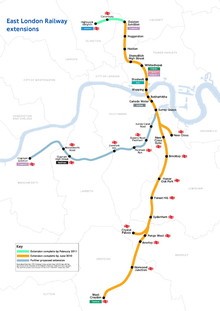
The East London line extension (ELLX) project is a British railway engineering project in London, managed by Transport for London. The project involves extending the East London Line (formerly part of the London Underground network) and making it part of the mainline London Overground network. This is being done by re-opening sections of disused railway line and by converting track electrified by the third-rail system, signalling, lineside signage and communication systems, etc. to mainline standards. New rolling stock was introduced and four new stations built along the route, with a fifth scheduled to be added in 2015.
The work, costing around £1 billion, began in 2005 and was carried out in two phases. The first phase was completed on 23 May 2010 with a service from Dalston Junction via the historic Thames Tunnel under the River Thames and along part of the Brighton Main Line to West Croydon and Crystal Palace. Trains also go to New Cross, where they make connection with the South Eastern Main Line. On 28 February 2011 the line was connected at its northern end to the North London Line at Highbury & Islington. In the second phase of the project, on 9 December 2012 a branch was connected to the South London Line enabling services to run to Clapham Junction.
Project overview
| London Overground | |||||||||||||||||||||||||||||||||||||||||||||||||||||||||||||||||||||||||||||||||||||||||||||||||||||||||||||||||||||||||||||||||||||||||||||||||||||||||||||||
|---|---|---|---|---|---|---|---|---|---|---|---|---|---|---|---|---|---|---|---|---|---|---|---|---|---|---|---|---|---|---|---|---|---|---|---|---|---|---|---|---|---|---|---|---|---|---|---|---|---|---|---|---|---|---|---|---|---|---|---|---|---|---|---|---|---|---|---|---|---|---|---|---|---|---|---|---|---|---|---|---|---|---|---|---|---|---|---|---|---|---|---|---|---|---|---|---|---|---|---|---|---|---|---|---|---|---|---|---|---|---|---|---|---|---|---|---|---|---|---|---|---|---|---|---|---|---|---|---|---|---|---|---|---|---|---|---|---|---|---|---|---|---|---|---|---|---|---|---|---|---|---|---|---|---|---|---|---|---|---|
Legend | |||||||||||||||||||||||||||||||||||||||||||||||||||||||||||||||||||||||||||||||||||||||||||||||||||||||||||||||||||||||||||||||||||||||||||||||||||||||||||||||
| |||||||||||||||||||||||||||||||||||||||||||||||||||||||||||||||||||||||||||||||||||||||||||||||||||||||||||||||||||||||||||||||||||||||||||||||||||||||||||||||
Phase 1
Phase 1 of the ELLX project involved the extension of the original line at its northern and southern ends. The northern extension runs from Whitechapel to Highbury & Islington, connecting with the North London Line; this section became operational as far as Dalston Junction in late May 2010, and to Highbury & Islington on 28 February 2011, with trains every 5 minutes on the central section between Dalston Junction and Surrey Quays.[1] The southern extension of phase 1 from New Cross Gate to Crystal Palace and West Croydon was completed simultaneously with that to Dalston in 2010 and a full service began in May 2010.[2]
The northern extension makes use of disused trackbeds on the Kingsland Viaduct that formerly carried the North London Railway branch to Broad Street station, closed to the national rail system in 1986. It bypasses Shoreditch station, which closed permanently in June 2006. The new line diverges before the closed Shoreditch station, traverses the former site of the Bishopsgate Goods Yard and crosses Shoreditch High Street on a bridge, before running north along the Kingsland Viaduct. Four new stations have been built at Shoreditch High Street, Hoxton, Haggerston and Dalston Junction. From there, the double-track line continues under Kingsland High Street and Boleyn Road and then parallels the existing North London Line with services running through Canonbury (for interchange with the North London Line eastbound) to Highbury & Islington (for interchange with the Victoria line, North London Line westbound and Northern City Line).[3]
The stations between New Cross Gate and Crystal Palace/West Croydon were previously managed by Southern, which ran all train services to these stations; they were later transferred to TfL control.[4]
The existing section of line was completely overhauled, with the replacement of all track and signalling upgraded to Network Rail standards.[5]
Phase 2
The ELLX Phase 2 project extended the line from Surrey Quays on to the Network Rail South London Line. Trains on this route run to Clapham Junction via Queens Road Peckham, Peckham Rye, Denmark Hill, Clapham High Street and Wandsworth Road. From Wandsworth Road, instead of running to Victoria, westbound trains branch off at Factory Junction, passing through Battersea towards Clapham Junction.[6][7]
After a period of uncertainty, funding for this phase was finally announced in February 2009, with a prospective completion date of May 2012, in time for the start of the 2012 Summer Olympic and Paralympic Games, held in London, in July 2012;[8] however, TfL later put back the opening date to 9 December 2012.[9]
A new station was proposed at Surrey Canal Road. In September 2010, funding for this was refused by the Department for Transport,[10] but the developer Renewal later agreed to fund it as part of its Surrey Canal development scheme, due to start in 2013, and Lewisham Council granted planning permission. The new station could open in 2015, depending on the pace of new housing development in the vicinity.[7][9]
At Clapham Junction, former Platform 2 is being divided into two separate, staggered platforms, Platform 1 (for the existing Overground services to/from Willesden Junction and Stratford) and Platform 2 (for the new services to/from Highbury & Islington).[7] In addition, a disused staircase at Platform 2 is being brought back into use and a new lift installed to improve access from the newly refurbished Grant Road entrance.[9][11]
Trains will run every 15 minutes between Clapham Junction and Highbury & Islington.[9] There are no plans to operate trains through from the South London line to the West London line, so passengers from one to the other will have to change at Clapham Junction.[7] Transport for London will take over the management of Clapham High Street and Wandsworth Road stations when the new service starts.[7]
Train services and rolling stock

The core section of the line, between Dalston and Surrey Quays, is served by 16 trains per hour. New Cross Gate to Sydenham has 8 trains per hour. The remainder of the line is served by four trains per hour.[12] A total of 30 stations are served by the new line.[13]
As part of the upgrade, new mainline rolling stock replaced the former London Underground A60 and A62 Stock, which had been in service for 50 years. As of 2012 the line operated 23 Class 378/1 "Capitalstar" four-car electric multiple units (similar to the Class 376 already in use by Southeastern), although some five-car units have since been introduced to meet demand. Unlike the London Underground stock which they replaced, the trains have longitudinal seating similar to most classes of Tube trains, to cater for the expected higher level of usage.[14]
Transfer to London Overground
The stations from New Cross Gate to Crystal Palace and West Croydon were previously managed by Southern, but London Overground took over control of these stations in September 2009 in preparation for the new London Overground services.[15]
Contractors
Parsons Brinckerhoff were selected by TfL as the programme managers in May 2005,[16] and in June 2005, TfL awarded Taylor Woodrow a £30 million contract to undertake enabling works on the Kingsland Viaduct and other sites. Mott MacDonald was also appointed the project's technical advisor.[17] The main works on the line were undertaken by a consortium of the engineering and construction groups Balfour Beatty and Carillion. TfL announced in October 2006 that the two companies had been awarded a £363 million contract to carry out the work, beating a rival consortium made up of Laing O'Rourke, AMEC Spie and Vinci.[18] Some 2,000 jobs were planned to have been created at the peak of the contract and the contractors were obliged to hire local staff. The contract awarded bonuses to the contractors if they complete work ahead of schedule, but penalised them up to £50,000 a day for late delivery.[19]
Carillion has also been awarded a contract to maintain the extended line. The seven-year £80 million contract, announced in February 2009, requires Carillion to provide TfL with management, technical resources, plant, equipment and labour.[20]
Bombardier supplied the line's rolling stock as part of a £259 million contract to provide trains for the London Overground network. In August 2006 Transport for London placed an initial £223 million order for 152 carriages, comprising 20 four-coach trains for the East London line and 24 three-coach trains for the North London line. The order was expanded in July 2007 at an additional cost of £36 million, to provide an extra three trains for the East London line. Manufacturing work began at Bombardier's Derby plant at the start of 2008 and the last train was scheduled to be delivered by May 2010.[21] The company beat three other bidders - Siemens, Hitachi and the rolling stock operating company Porterbrook, which would have supplied pre-owned trains.[22]
Funding
On 12 October 2004 the Mayor of London confirmed that phase one of the East London Line Project would be delivered as part of the Capital Investment programme. On 16 November 2004 he announced that control of the project had passed from the Strategic Rail Authority to TfL, so that the project could be initiated and funded from TfL's five-year investment programme. The planned service was initially described as a "metro-style (National Rail) train service".[23]
The bulk of the funding for phase 1 of the project was provided by the European Investment Bank, which granted TfL a loan of £450m (€660m). The bank's involvement was intended to promote the regeneration of the deprived areas of London through which the line runs.[24] The second phase of the project is being co-funded by the Department for Transport, which is providing £64 million, and TfL providing a further £11 million.[25] This funding does not cover the £10 million cost of building a new station at Surrey Canal Road and it remains unclear whether the station will be built, but provision is being made for it to be built at a later date.[26] It has been suggested that Millwall Football Club might contribute to the cost of the new station, which would be close to The Den football ground.[27]
History
Proposals and problems
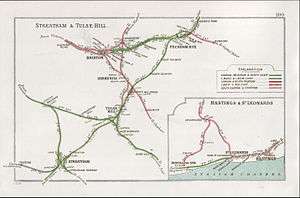
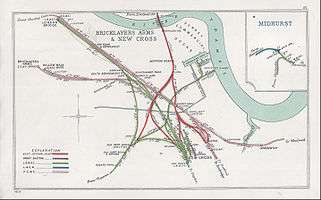

Extensions of the East London line have been discussed for many years. During the 1980s London Transport considered converting the line into a light railway similar to the Docklands Light Railway, or restoring the disused connection to Liverpool Street.[28][29] By 1989 a proposal had emerged to extend it north to Dalston and south to Peckham Rye and Dulwich, sharing track and stations with the mainline network, in a similar fashion to parts of the Bakerloo line, District line and Metropolitan line. The plan was costed at £100-£120 million and the extended line was envisaged to open in 1994.[30] The extension project was proposed several times during the 1990s but was repeatedly rejected or postponed owing to lack of government support and insufficient financing. In November 1990 Transport Secretary Cecil Parkinson rejected a proposed parliamentary Bill that would have authorised the project[31] and two years later the extension plans were postponed indefinitely owing to cutbacks in Tube funding.[32] Another proposal was made in 1993 to extend the line from Whitechapel to Dalston Junction, involving the construction of new stations at Bishopsgate, Hoxton and Haggerston,[33][34] and received the support of a public inquiry in 1994. Construction was envisaged to begin in 1996 and to be completed by 1998. The project was finally approved by the Government in 1996[35] but a lack of financing again forced the project to be put on hold in 1997.[36]
A solution to the funding issue was found in 1999 when London Transport announced that it was seeking private funds to realise the extension plans.[37] Control of the project was given to the Strategic Rail Authority rather than to London Underground, in view of the impact that it would have on mainline services. It was also proposed that the East London line and other sub-surface Underground lines would be transferred to Railtrack, the privatised company responsible for maintaining the mainline network. This would have seen the line integrated with the London suburban commuter network.[38] However, it was soon decided that this was impractical and the Railtrack proposal was abandoned.[39]
Network Rail's South London Route Utilisation Strategy in 2008 considered changes to the South London Line services unavoidable, particularly in respect of the even more restricted capacity during the reconstruction of London Bridge.[40]
Alternative routes
A number of different routeing proposals were put forward before the route of the northern, southern and western extensions was finalised.
The southerly route across south London's existing network of suburban railways underwent many changes before a final route was decided. Initial proposals around 1992 envisaged the western extension running from Peckham Rye to East Dulwich.[41]
Construction

The East London Line extension project was officially initiated by the Government on 9 October 2001,[42] with construction of the northern extension due to begin in December 2001. However, it was held up when it came to light that the Grade II listed 19th-century Braithwaite arches in the former Bishopsgate Goods Yard were to be demolished as part of the project. Campaigners launched legal action against London Underground in an effort to prevent the demolition, but the project finally received legal clearance in the Court of Appeal on 7 July 2003.[43]
Because of an inability to extend the platforms at the existing Wapping and Rotherhithe stations and make them fully compliant with current rail safety regulations, it was thought that they would close, but on 18 August 2004 Ken Livingstone, Mayor of London, announced that both stations would remain open.
Preparatory work by Taylor Woodrow began in June 2005 and continued through to the end of 2006, involving the replacement and refurbishment of 22 bridges along the Kingsland Viaduct.[44] On 9 June 2006, Shoreditch underground station closed permanently to facilitate work on the extension, with services from Whitechapel being replaced by buses.[45] The rest of the East London line closed on 22 December 2007, with rail replacement buses linking the stations north and south of the Thames (but not crossing the river due to height restrictions in the Rotherhithe Tunnel).[46]
On 5 September 2006 it was announced that the line would form part of the London Overground, branded with a version of the Underground roundel with red replaced by orange, the colour used on Tube maps for the East London Line.
| Wikinews has related news: Union criticizes East London Line 'privatisation' |
Three major new bridges were installed on the line between March and May 2008. On 29 March 2008, a new bridge weighing 350 tonnes was lifted into place over Shoreditch High Street. The bridge was manufactured to a tied arch or bowstring design in Chepstow by engineering firm Fairfield Mabey, and was lowered into place by the UK's biggest mobile crane, weighing 1,200 tonnes.[47]
On 3 May 2008, a 1,300-tonne Warren truss bridge (GE19 bridge) spanning Great Eastern Main Line tracks out of Liverpool Street station was put into place. Although the bridge launch was successful, on 28 May the bridge dropped 200 mm onto its permanent supports as it was being jacked down. Debris fell onto the tracks, forcing the suspension of services in and out of Liverpool Street station until the following day and causing major disruption to commuters. The problem was traced to errors made by the sub-contractors.[48][49]
The last of the three bridges, a 600-ton truss steel structure, was put in place at New Cross Gate between 10 and 12 May 2008.[50] Test running on the completed line began on 5 October 2009.[51]
Re-opening

Before the full service launch, a limited "preview" service began on 27 April 2010 between Dalston Junction and New Cross/New Cross Gate,[52] and the line came into full operation between Dalston Junction and West Croydon/Crystal Palace on 23 May.[53]
The proximity of the line re-opening date to the forthcoming parliamentary general election also generated speculation about political motives, with opposition parties suggesting Mayor Boris Johnson was seeking to make political capital out of a project originally begun by his predecessor and political opponent Ken Livingstone.[54]
Highbury & Islington
On 28 February 2011 the line was extended northwards to Highbury & Islington.[55]
Gallery
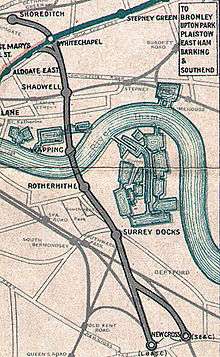 A 1915 map of the original East London Line
A 1915 map of the original East London Line- New Cross Gate, during conversion from Tube terminus to a through station
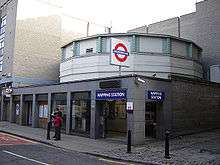 Wapping station in its last days as a Tube station
Wapping station in its last days as a Tube station Wapping station after its conversion to London Overground
Wapping station after its conversion to London Overground- Hoxton station on the first day of full operation
- Denmark Hill is linked to the East London Line
References
- ↑ "London Overground: Highbury & Islington to West Croydon". Transport for London. n.d. Retrieved 5 July 2012.
- ↑ "Ten thousand free tickets mark first full service on London Overground's East London route" (Press release). Transport for London. 18 May 2010.
- ↑ "East London Line Northern Extension and Silwood Servicing Facility" (PDF). Transport for London. Retrieved 15 February 2009.
- ↑ "South Central Franchise Consultation" (PDF). Department for Transport. May 2008. Retrieved 9 June 2009.
- ↑ Wright, Robin (24 October 2006). "East London line contract awarded as part of 2012 transport boost". Financial Times. London. p. 6.
- ↑ Transport for London (2006). "The Tube in 2010". Retrieved 3 November 2007. (map illustrating future development phases as proposed by TfL in 2006, subject to change)
- 1 2 3 4 5 Clinnick, Richard (27 July 2011). "East London Line to run extra trains ahead of schedule". Rail. Peterborough. pp. 12–13.
- ↑ "Final section of Capital's orbital railway gets the go-ahead" (Press release). Transport for London. 12 February 2009. Retrieved 4 July 2012.
- 1 2 3 4 "London Overground Clapham Junction to Surrey Quays". Transport for London. n.d. Retrieved 4 July 2012.
- ↑ "Transport minister refuses funding for key south London station". UK Construction News. 3 September 2010. Retrieved 5 September 2010.
- ↑ "Grant Road entrance closed from 6 June until early July 2012" (PDF). Transport for London. 2012. Retrieved 5 July 2012.
- ↑ East London Line Extensions. Islington Council, 31 October 2008.
- ↑ "East London line". Transport for London. Retrieved 15 February 2009.
- ↑ "London Overground Suburban Network, United Kingdom". Railway Technology. Retrieved 15 February 2009.
- ↑ "Ten rail stations to be managed by Transport for London" (Press release). Transport for London. 16 September 2009. Retrieved 27 May 2010.
- ↑ "East London Line appoints programme managers" (Press release). Transport for London. 11 May 2005. Retrieved 17 March 2009.
- ↑ "East London Line is moving at pace" (Press release). Transport for London. 3 June 2005. Retrieved 17 March 2009.
- ↑ "Balfour Beatty and Carillion win £363m East London line contract". The Guardian. London. 23 October 2006. Retrieved 15 February 2009.
- ↑ Osborne, Alistair (24 October 2006). "Balfour Beatty wins £363m contract to extend East London rail link". The Daily Telegraph. London.
- ↑ "Carillion wins 80 mln stg East London Line deal". Reuters. 9 February 2009. Retrieved 15 February 2009.
- ↑ Johnson, Robin (5 July 2007). "Train-maker wins £36m extension to contract". Derby Evening Telegraph. p. 20.
- ↑ Webb, Tim (8 January 2006). "East London Line's £100m bids". The Independent on Sunday. London. Retrieved 16 February 2009.
- ↑ "East London Line Project Status". Transport for London. Archived from the original on 10 October 2004. Retrieved 31 May 2010.
- ↑ "Transport for London EIB Loan of £450m for East London Line Project in preparation for 2012 Olympic and Paralympic Games" (Press release). Transport for London. 21 December 2005. Retrieved 16 February 2009.
- ↑ Barney, Katharine (12 February 2009). "East London railway extension to Clapham is given the go-ahead". London Evening Standard. Retrieved 16 February 2009.
- ↑ Willoughby, Michael (12 February 2009). "Two top Crossrail roles unlikely to double up". Building. Retrieved 16 February 2009.
- ↑ Stringer, Michael (23 February 2009). "Millwall to save Surrey Canal Road?". South London Press. Retrieved 17 March 2009.
- ↑ Financial Times. London. 10 April 1987.
A working party set up by London Regional Transport and British Rail to examine potential sites for light railway networks in London has revealed its findings
Missing or empty|title=(help) - ↑ "Booming Tube lines may be extended". The Times. London. 10 April 1987.
- ↑ "Dalston-Dulwich Tube likely to go ahead". Financial Times. London. 22 December 1989.
- ↑ "Way open for private rail link to City of London". The Guardian. London. 21 November 1990.
- ↑ "The cuts run deep for London Underground". Financial Times. London. 14 November 1992.
- ↑ "Moves to extend East London Line". Building. 14 May 1993.
- ↑ "East London Line - London Underground to seek consent". Estates Gazette. London. 4 December 1993.
- ↑ "Final approval given for powers to construct East London Line northern extension." Department of Transport. 16 January 1997.
- ↑ "Where Tube axe falls". The Times. London. 21 February 1997.
- ↑ "Underground to be extended with private funds - London Transport". The Times. London. 8 February 1999.
- ↑ "Railtrack lines up the prospect of non-stop travel across London". Financial Times. London. 16 June 1999.
- ↑ "1999 Railtrack and the Underground" (Press release). UK Government. 1 December 1999.
- ↑ "South London Route Utilisation Strategy" (PDF). Network Rail. March 2008.
- ↑ Arthurton, R.I.M.; Institution of Civil Engineers (Great Britain) (1993). "26. Moving the Masses by Heavy Metro p.306". In B. H. North. Modern Railway Transportation. Thomas Telford. p. 394. ISBN 978-0-7277-1973-7.
- ↑ "Tube line extensions 'approved'". BBC News Online. London. 9 October 2001. Retrieved 16 February 2009.
- ↑ "Tube scheme back on track". BBC News Online. London. 7 July 2003. Retrieved 16 February 2003.
- ↑ "Transport for London awards £363m contract to build new East London Railway" (Press release). Transport for London. 23 October 2006. Retrieved 16 March 2006.
- ↑ "Hackney to get its first Tube station". The Londoner. Mayor of London. June 2006. Archived from the original on 30 September 2007. Retrieved 16 March 2009.
- ↑ Lyon, Sam (21 December 2007). "Tube line shut until 2010". London Evening Standard. Retrieved 17 March 2009.
- ↑ "Britain's biggest mobile crane helps build the new East London line" (Press release). Transport for London. 28 March 2008. Retrieved 16 March 2009.
- ↑ "Rail bridge debris halts services". BBC News Online. 29 May 2008. Retrieved 16 March 2009.
- ↑ "Report into East London Line bridge incident released" (Press release). Transport for London. 15 August 2008. Retrieved 16 March 2009.
- ↑ "Three bridges in a row for East London line extension" (Press release). Transport for London. 23 April 2008. Retrieved 16 March 2009.
- ↑ "Commissioner's Report" (PDF). Transport for London. October 2009. Retrieved 28 May 2010.
- ↑ "New era of rail travel as London Overground's east London route opens to the public" (Press release). Transport for London. 27 April 2010. Retrieved 27 May 2010.
- ↑ "Full service begins on newly extended East London Line". BBC News Online. London. 23 May 2010. Retrieved 27 May 2010.
- ↑ "East London Line reopening dubbed 'political stunt'". BBC News Online. 14 April 2010. Retrieved 16 April 2010.
- ↑ "Highbury & Islington extension in May 2011". Transport for London.
Further reading
- Wayne Asher. 2015. A Very Political Railway - the rescue of the North London Line. ISBN 978-1-85414-378-5
- John Glover. 2013. London's Overground. ISBN 978-0-7110-3524-9
External links
| Wikimedia Commons has media related to East London Line. |
| Wikimedia Commons has media related to South London Line. |
- East London line - London Underground website
- East London line Project (official TfL home page)
- East London line Project (official Balfour Beatty/Carrilon home page)
- ELL route through Shoreditch
- Video Flyover of Phase 1